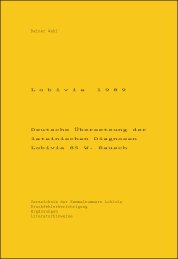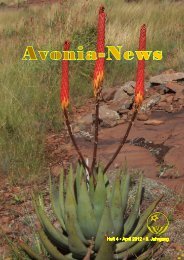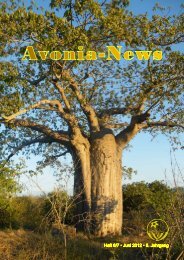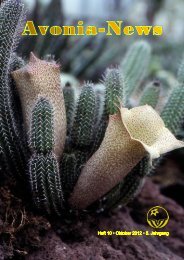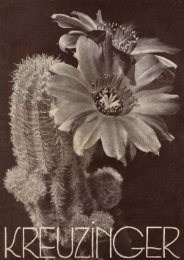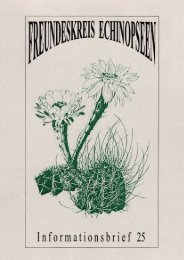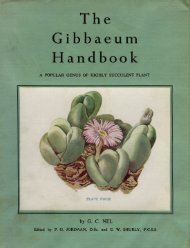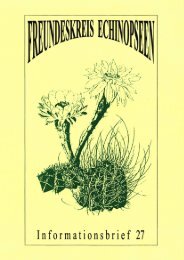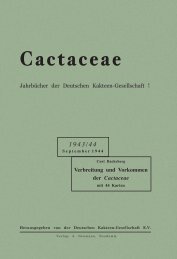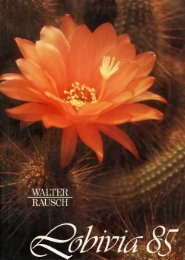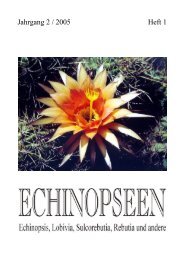Lithops - Au Cactus Francophone
Lithops - Au Cactus Francophone
Lithops - Au Cactus Francophone
You also want an ePaper? Increase the reach of your titles
YUMPU automatically turns print PDFs into web optimized ePapers that Google loves.
two leaves entirely. Dinter extended this rule to a more general one that all<br />
seedlings with a circular opening (Schlitzkeimlinge, Group A) were those of<br />
species with white flowers, whereas the seedlings with a fissure separating the<br />
two leaves (Spaltkeimlinge, Group B) belonged to plants with yellow flowers.<br />
Unfortunately Dinter and Rusch only examined about 28 then known spe<br />
cies and these mainly from South West Africa. The 28 species enumerated<br />
by Dinter must be considerably reduced in number, as there are a number of<br />
synonyms amongst them. Whether this rule can he upheld for all species is<br />
a question which the future must decide.<br />
Dinter states that the correct time to determine whether the plant or<br />
seedling belongs to one or other of the above groups is from the three weeks<br />
old stage until just before the cotyledonary leaves (first leaves) dry up.<br />
Dinter gives a list of the following plants whose seedlings Rusch and<br />
himself had examined;<br />
Group A (yellow flowers, seedling with circular opening)<br />
L. Comptonii L. kuibisensis L. Ruschiorum<br />
L. Dinteri L. kunjasensis L. Schwantesii<br />
L. fulviceps L. olivacea L. urikosensis<br />
L. Franciscii L. pseudotruncatella L. Vallis‑Mariae<br />
L. gracilidelineata<br />
Group B (white flowers and fissure)<br />
L. bella L. Eberlanzii L. Fulleri<br />
L. karasmontana L. optica.<br />
This list is a modification of the one given by Dinter. The synonyms<br />
have been omitted.<br />
DESCRIPTION OF GENUS<br />
Body single or forming clumps of 2–20, embedded in the soil, usually<br />
2–6 cm. in diameter, turbinate: top surface plain, convex, oblique convex or<br />
obconical: top surface forming large transparent areas often reduced to minute<br />
impressed lines or dots, sometimes only transparent miniature windows raised<br />
or embedded in the body: window sometimes with few or many islands or<br />
covered with an opaque covering perforated by circular openings: window very<br />
often bordered by a narrow buff band: top surface plain or rugose, with or<br />
without darker coloured impressed lines, with or without red to dark red lines<br />
or dots embedded in the body or raised above the surface: sometimes warts<br />
between the elevations, sometimes with dendritic markings: window with or<br />
without a laciniated or denticulated margin, margin sometimes absent or in<br />
ner margin straight, or with a triangular clear part at junctions of two mar<br />
gins: colour of top surface white creamy white, grey white, yellowish white,<br />
yellowish, green, green white, pink, reddish to purplish (Figs. 12 and 13).<br />
25



